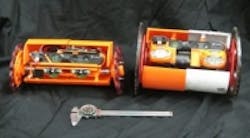Vision-guided robots to study volcano in NASA project
Researchers at NASA’s Jet Propulsion Laboratory are developing 3D vision-enabled robots that will be dropped into volcanoes in order to gain new insights into how volcanoes erupt.
MORE ARTICLES
NASA team developing “swarmie” robots for autonomous scouting and resource collection
The first iteration of the project, VolcanoBot1, was tested at Kilauea volcano in Hawaii in May of 2014. The robot, which is equipped with a 3D sensor that looks similar to a Microsoft Kinect, was able to descend to depths of 82 ft. in two locations on the volcano’s fissure. Using VolcanoBot, the researchers were able to create a 3D map of the fissure. During the project, the VolcanoBot 1 also discovered that the fissure does not pinch shut at the bottom, so the team decided to build another version of the robot in order to go even deeper and investigate further.
Carolyn Parcheta, NASA postdoctoral fellow at JPL and a team have developed the VolcanoBot 2. With it, the team hopes to be able to get to areas of the volcano that humans are unable to go, and the previous robot could not reach, to learn more about volcano eruptions.
"We don't know exactly how volcanoes erupt. We have models but they are all very, very simplified. This project aims to help make those models more realistic," Parcheta said.
The second VolcanoBot is a smaller, lighter version of its predecessor and will have an electrical connection that is more secure and robust so that researchers can use the 3D sensor's live video feed to navigate. In addition, unlike VolcanoBot 1, which sent data to the surface directly from inside the fissure, data onboard VolcanoBot 2 will be stored onboard. In addition, the new robot will have a vision system that is able to pan and tilt.
The research was honored in National Geographic's Expedition Granted campaign, which awards $50,000 to the next "great explorer," has implications for extraterrestrial volcanoes, according to the JPL. Specifically, on both Earth and Mars, fissures are the most common physical features from which magma erupts. This may also prove to be true for previously active volcanoes on the moon, Mercury, Enceladus, and Europa, although the mechanism of volcanic eruption—whether past or present—on these other planetary bodies is unknown, Parcheta said.
"In the last few years, NASA spacecraft have sent back incredible pictures of caves, fissures and what look like volcanic vents on Mars and the moon. We don't have the technology yet to explore them, but they are so tantalizing! Working with Carolyn, we're trying to bridge that gap using volcanoes here on Earth for practice. We're learning about how volcanoes erupt here on Earth, too, and that has a lot of benefits in its own right," said JPL robotics researcher Aaron Parness.
The team plans to test VolcanoBot 2 at Kilauea in early March.
View the JPL press release.
Share your vision-related news by contacting James Carroll, Senior Web Editor, Vision Systems Design
To receive news like this in your inbox, click here.
Join our LinkedIn group | Like us on Facebook | Follow us on Twitter | Check us out on Google +
About the Author

James Carroll
Former VSD Editor James Carroll joined the team 2013. Carroll covered machine vision and imaging from numerous angles, including application stories, industry news, market updates, and new products. In addition to writing and editing articles, Carroll managed the Innovators Awards program and webcasts.
